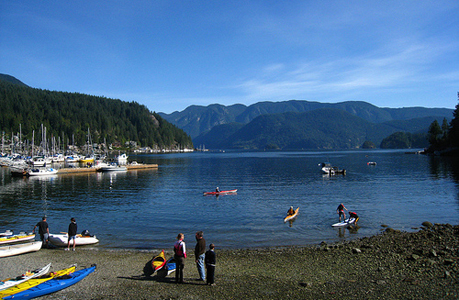
As much as Vancouver has to offer on land – from world-class cuisine to stunning parks – one of the best ways to experience the city is on the water. Downtown is almost completely surrounded by inlets and bays, while sounds, fjords and estuaries riddle the nearby coastline.
And one of the easiest ways to get out on the water is in a kayak. Relatively cheap to rent and easy to use, with little or no experience required, kayaks are nimble enough to maneuver along the shoreline and offer a unique perspective on Canada’s city by the sea.
False Creek, Jericho Beach and English Bay are popular spots, but there’s plenty of great kayaking for beginners and experts alike up and down the coast. And the creme de la creme for kayaking – offering calm waters and a spectacular backdrop – might just be Deep Cove, a suburb set along a 25-kilometre fjord that extends from the Burrard Inlet.
I drove out to Deep Cove to experience it for myself over the weekend. The small community is only a 30-minute trip from downtown Vancouver, near the eastern end of Burrard Inlet, but it feels much more remote. The little Main Street – lined with ice cream shops and fish-and-chips joints – slopes gently down to the cove, where heavily forested mountains plunge to the water.
I rented a double kayak from Deep Cove Kayak and Canoe, which is right on the beach and hard to miss ($50 for two hours). After strapping into our life vests, my partner and I pushed off from shore. Despite the fact that we’d never kayaked before, it wasn’t hard to get a feel for the boat. A simple foot-controlled rudder handles the steering, and the paddles provide the power. Soon enough, we were paddling past the Deep Cove marina and spotted three seals – including one baby – lounging on a log floating in the water.
We stuck close to the western shore of Indian Arm (the fjord that extends from Deep Cove), paddling by remote seaside mansions accessible only by boat, sheer cliffs that dropped straight to the water and sandy beaches. Because Indian Arm is so far from open water, the experience is more like being on a lake than on the ocean – the biggest waves generally come from the wake of passing motor boats.
The one thing newbies should know about kayaking is that it is a workout. After an hour, our arms were burning and we decided to pull a u-turn and head back to town. On the way back, however, we ended up fighting the tide. The sky clouded over and the wind picked up, making the return trek a little challenging. But by the time we floated back into Deep Cove, we were worn out but definitely ready to explore some of the other kayaking opportunities around the city.
Have you kayaked Deep Cove? Do you have a favourite place to kayak in Vancouver?





